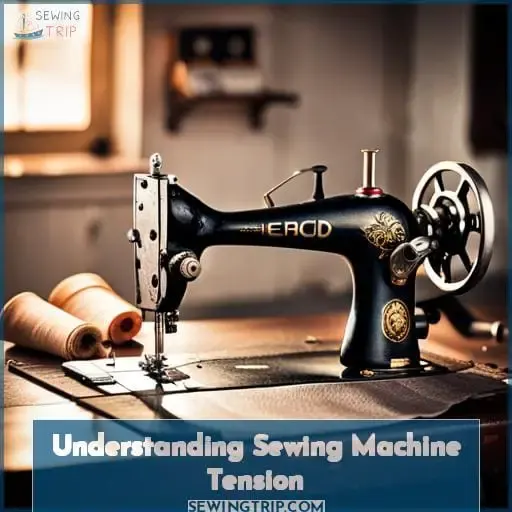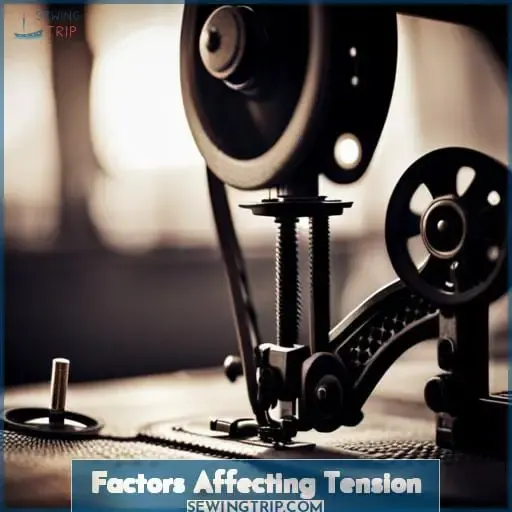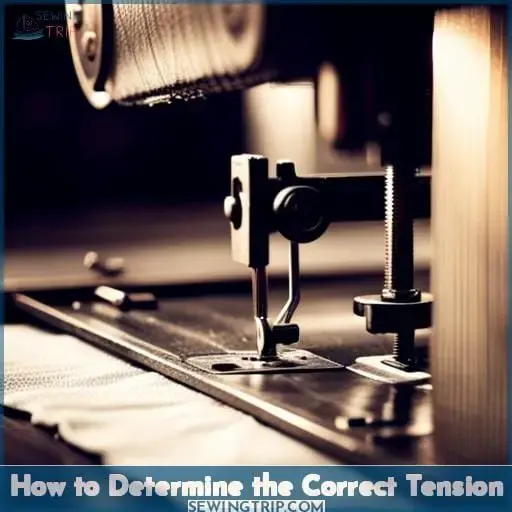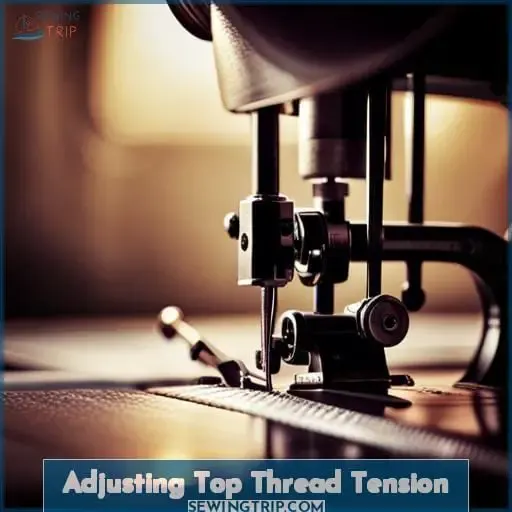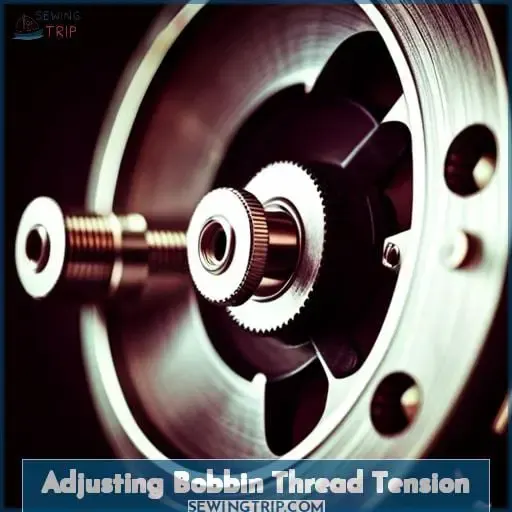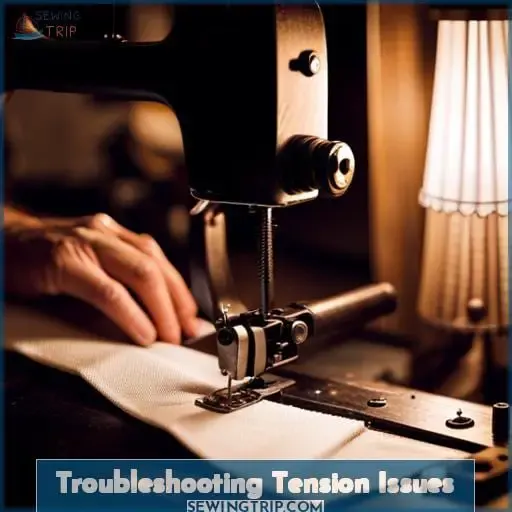This site is supported by our readers. We may earn a commission, at no cost to you, if you purchase through links.
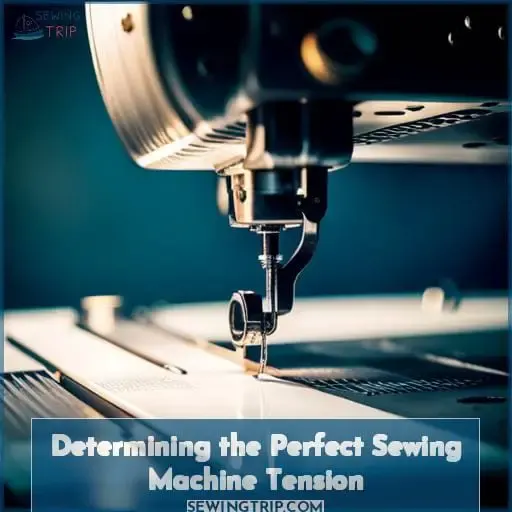 Troubleshooting sewing machine tension can be tricky, even for experienced sewers. This guide will help you understand how to determine the right tension for your project.
Troubleshooting sewing machine tension can be tricky, even for experienced sewers. This guide will help you understand how to determine the right tension for your project.
First, how do you know if your tension needs adjusting? Signs of incorrect tension include puckered seams, looping on the underside of the fabric, or thread breakage.
When adjusting tension, start with the presser foot up. The top thread should pull freely with a gentle tug. If it feels too loose or too tight, turn the tension dial. Go slowly and test after each minor adjustment by pulling the top thread again.
The correct tension varies by fabric. Lightweight fabrics like chiffon need a low tension setting. Heavier fabrics like denim require more tension. Find the lowest setting that avoids loose top threads or looping bobbin threads below.
Don’t forget to check the bobbin tension too. The bobbin thread should cross over the top thread slightly on the fabric’s underside.
With some trial and error, you’ll find the ideal tension for smooth seams. Be patient, go slowly, and test between adjustments.
Table Of Contents
Key Takeaways
- Troubleshooting sewing machine tension can be challenging.
- Carefully adjust the top thread tension gradually to find the perfect balance between the top and bottom threads.
- Check the bobbin tension and ensure even winding of the bobbin thread.
- Use high quality thread, clean any lint buildup in the machine, and choose the correct needle size and type for your fabric.
Understanding Sewing Machine Tension
You’ll need to adjust the tension dials to find the sweet spot that balances the threads for your project. Proper sewing machine tension is all about achieving balance between the top thread and the bobbin thread.
The key is setting the tension dials so that the threads lock together in the middle of the layers being sewn. If the tensions are off, you’ll end up with messy stitches, puckering seams, or thread nests.
Start by ensuring your machine is threaded correctly and the bobbin is wound evenly. Then, make small turns of the tension dials while test sewing on scraps. Tighten or loosen each thread gradually until you find the tension that produces even, consistent stitches on both sides of the fabric.
Quality stitching requires finding that ideal balance through tension adjustments.
Factors Affecting Tension
Knowing the proper thread tension setting for your machine, thread, and fabric makes all the difference for quality stitching. With a bit of adjustment to top thread tension, and by troubleshooting any issues, you can achieve a balanced and stable tension to sew any project.
Proper thread tension results in even, consistent stitches without puckering, gathering, or looping. Check your owner’s manual for the recommended tension setting for your sewing machine model and adjust accordingly.
Test on fabric scraps first before sewing your project. Loose top tension causes looping on the underside, while too tight causes puckering. Adjust in small increments and re-test until the tension is just right. Make sure the presser foot pressure is also adjusted properly.
Use quality thread and change needles frequently. Clean lint buildup and use the right needle for your fabric type. With some trial and error, you’ll find the right tension balance for smooth sewing.
Importance of thread tension
Thread tension is the invisible force that makes or breaks your stitching, so mastering it elevates your sewing skills. Achieving balanced tension between the top and bottom threads results in consistent stitching, neat seams, and professional finishes.
Troubleshooting tension issues and understanding how to adjust it perfectly for each fabric transforms novice stitching into expert results. Following thread tension tips and gaining experience understanding this crucial concept are the keys to ideal stitching and trouble-free sewing.
Adjusting top thread tension
As if you’re surviving ravaging winds, crank the top thread tension dial with every ounce of power in your limbs to secure those stitches. That thread path controls stitch tightness like a master puppeteer. Tug the strings for thick fabrics, release for sheers.
Yet the bobbin’s fixed fortress demands no adjustment once set. Wrestling with tension dials grants dominion over your machine’s temperament. Wield that control to conquer imperfect seams and liberate your potential through understanding.
Troubleshooting tension issues
Try adjusting the tension dials gradually if you keep getting loops on top or bottom, and test on scrap fabric first. Turn the bobbin tension screw clockwise to tighten, counterclockwise to loosen if needed.
Make sure high quality thread passes cleanly through the tension disks. Inspect the throat plate for damage. If problems continue, consider free motion embroidery workshops or professional assistance.
How to Determine the Correct Tension
Transitioning to determining the ideal tension for your project involves both testing the current settings and evaluating the results. Start by considering your thread, fabric thickness, and desired stitch style. While machines often default around 4-5 for balanced tension, adjustments may be required.
To test tension, sew samples using scrap fabric identical to your project’s. Assess the stitching, watching for these signs:
- Loops on the underside mean loose top tension.
- Loops on top indicate too tight top tension.
- Well-balanced tension shows even, flat stitching top and bottom.
- Zigzag and decorative stitches may need adjusted top tension.
- Thicker threads and fabrics require higher tension settings.
- Very thin fabrics need reduced tension to prevent puckering.
By methodically testing tension on scraps first, you can dial in the optimal settings before sewing your final garment or project. Achieving balanced tension is crucial for professional results and attractive finishing.
Adjusting Top Thread Tension
You’ll want to turn that tension dial slowly to find the sweet spot. Adjusting top thread tension starts with understanding proper thread balance.
Locate the tension dial on your machine’s thread path. Turn it while sewing on a test scrap, checking the stitch formation often. Gradually increase tension if the top thread is loose or forms loops on the underside.
Decrease tension if the bobbin thread pulls to the top or forms loops on the right side.
Quality thread resists excess twisting or stretching, helping you find the tension sweet spot for your project. Match the thread weight to the fabric and needle. Check for issues like threading errors or damage before adjusting tension.
Be patient, test frequently, and make small turns of the dial for ideal control. With practice, you’ll learn when the tension feels just right for different fabrics and threads.
Adjusting Bobbin Thread Tension
Now, make certain your bobbin is wound smoothly. Uneven winding creates inconsistencies in tension. Check that the bobbin fits snugly in the bobbin case. Slipping during sewing disrupts thread control.
Note the tension spring’s position. If loose, turn it clockwise slightly to firm up thread take-up. However, minimal adjustments prevent over-tightening. Test by holding the bobbin case and dangling the thread.
The thread shouldn’t unwind freely or drop rapidly. For troubleshooting, ensure the case stays threaded properly when inserting. Exercises identify specific issues: Does the thread catch and snap upward or sink downward when pulled? Target adjustments accordingly.
Troubleshooting Tension Issues
Focus on inspecting the tension discs while threading carefully to identify issues before trouble strikes. Achieving the perfect stitch requires balancing tension between the top thread and bobbin.
- Check threading path. Ensure the thread is seated correctly between the tension discs.
- Inspect needle condition. Change bent or damaged needles which cause irregular stitching.
- Clean machine. Remove lint and oil buildup that interfere with smooth thread delivery.
Getting the tension right takes patience but is worth it. With balanced tension, your stitching will be smooth, even, and professional-looking on any fabric. Don’t let tension trouble disrupt your creative flow. Stay focused on precision threading and regular machine maintenance for frustration-free sewing.
Conclusion
Achieving the perfect sewing machine tension is essential for any successful sewing project. Like a symphony of threads, the appropriate tension ensures the top and lower threads are balanced to construct stable seams and exquisite stitching.
By comprehending the impact of thread tension, you can adjust the top and bottom threads fittingly and troubleshoot any tension predicaments that may occur. With slight practice and patience, you can find out the precise tension for any cloth or stitch category, and guarantee your endeavors are impeccably tailored to your distinctive style.

